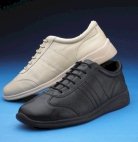Shoe Shopping
 Find a shoe that fits your foot. When you are shopping for shoes, it is especially important to purchase shoes that fill well to avoid painful foot problems. The following guidelines, developed by the American Orthopedic Foot and Ankle Society, can help you.
Find a shoe that fits your foot. When you are shopping for shoes, it is especially important to purchase shoes that fill well to avoid painful foot problems. The following guidelines, developed by the American Orthopedic Foot and Ankle Society, can help you.
- Have your shoes fitted at the end of the day when your feet are the largest.
- Stand while being fitted (this is when your foot is the longest and widest), and fit the shoe to the largest foot.
- Sizes vary among shoe brands and styles. Pick the shoe by how it fits your foot-not by the size marked inside.
- Select a shoe that conforms to the shape of your forefoot as closely as possible. There should be one finger's breadth-about ½ inch-between your longest toe and the end of the shoe. For the greatest comfort, the shoe should be no more than ¼ inch narrower than the width of your foot. The ball of your foot should fit snugly into the widest part of the shoe, without being overly tight, even if this means that your heel is slightly loose.
- While you are still in the store, walk around to make sure that the fit feels correct.
- Avoid buying shoes that fit poorly. Do not expect them to "stretch to fit." Shoes that fit correctly do not need to be broken in.
A note to women:
Shoes with a very high heel and a narrow toe constrict the foot and can cause pain and deformity. If you must wear high heels, try to select styles with a lower heel and roomier, preferably rounded, toe. Try to limit the amount of time you spend in high heels. For example, you might switch to tennis shoes for the office commute or lunchtime trip into town.

